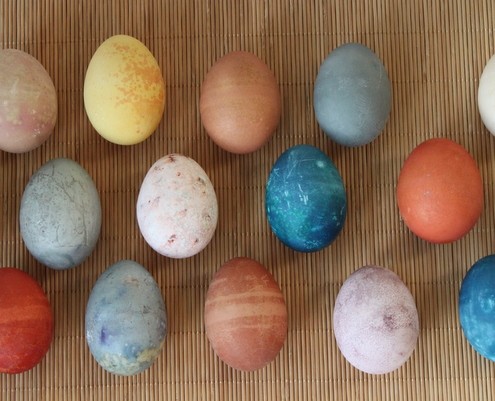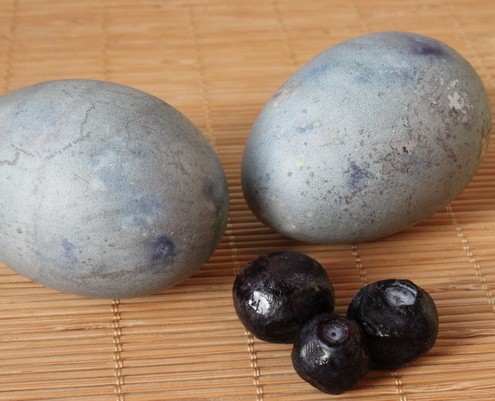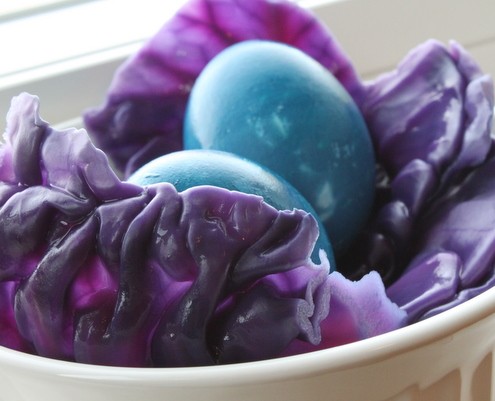Egg dyeing is an almost worldwide Easter tradition, and Kelsey Hilts has some great tips to natural dyeing.
Text And Photos By Kelsey Hilts
Appreciate the vivid colors and natural beauty of fruits, vegetables and spices: dye your Easter eggs with everyday foods rather than boxes of chemical colorings. This is a great family project and learning experience. Though it will take a little more planning than your basic Easter egg dye box, I think you will find the extra time well worth it. Even though I’m a grown-up, I felt a child-like excitement watching the eggs turn colors in bowls of cabbage, spinach, blueberries and more!
With some of the dyes, it is best to boil the eggs with the natural substance to achieve the most vibrant color. I have indicated these below with an asterisk. With others, you can hard-boil the eggs first and then soak them in the respective natural dye.
For more vibrant colors, place the sealed containers of natural dyes in the refrigerator and let the cooked eggs soak overnight. Adding vinegar to the boiling water will also help make the colors brighter. (One exception is with onion skins; do not add vinegar to the onion skins.) If you want shiny eggs, rub them with some vegetable oil once the dye is dry.
I have listed below the foods that I tried along with my comments. The ones in bold were my favorites. I have also listed a few recommendations that I didn’t try this time around but that I’ve heard work well. Let your kids take part in the brainstorming process of deciding what foods to use. And watch as they are surprised and amazed at the results. (I didn’t expect purple cabbage leaves to turn the eggs bright blue!)
What you’ll need:
White Eggs
Cold Water
Vinegar (Roughly 2 Tbsp to every pot of eggs you boil, except for the onion skins)
Natural Dye Ideas:
Pink – Beets* – I cut one beet into chunks and cooked it with the eggs. The eggs turned a pale Victorian pink. For a brighter pink, I will try grating the beets next time or soaking pre-cooked eggs in beet juice.
Yellow – Golden Beets (in chunks)* – I cut one golden beet into chunks and cooked it with the eggs. The dye was a bright yellow but the eggs only turned a very pale yellow. For a brighter yellow, I will try soaking pre-cooked eggs in golden beet juice.
Yellow – Turmeric – I put about 1 tsp turmeric powder in a small jar of water (big enough for only one egg). The egg turned bright yellow with some orange specks.
Other Yellow Options – Orange Peels*, Green Tea, Cumin
Orange – Chili Powder – I put about 1 tsp chili powder in a small jar of water (big enough for only one egg). The egg turned a very pale orange. I probably won’t do this one again; I will try carrots or carrot juice instead.
Other Orange Options – Carrots (in chunks)* or carrot juice
Blue – Crushed Blueberries – I put about 1/4 cup frozen blueberries in a tall glass of water with two cooked eggs. I stirred the blueberries, squishing them against the glass and the eggs. The eggs turned a pale blue with some very interesting specks and streaks where the fruit touched the shell.
Blue – Purple Cabbage Leaves* – I boiled two eggs with roughly half of a head of purple cabbage. It was a surprise because contrary to the striking purple color of the dye, the eggs turned a brilliant bright blue.
Green – Spinach* – I boiled a bag of spinach with two eggs. The dye was very pale so I added a box of frozen spinach in hopes of intensifying the green. The eggs stayed a very pale green. For a brighter green, next time I will try soaking pre-cooked eggs in spinach juice.
Other Green Options – Grass (rinsed and blended with water)
Orange-Brown – Red Onion Skins* – I boiled two eggs with the skins of roughly three red onions. I expected the eggs to be a pale blue or purple but they turned a light brownish-orange. Next time I will try adding some of the actual shiny bright purple onion flesh to hopefully get more of a violet blue color.
Red – Lots of Red Onion Skins*
Violet Blue – Red Onion Skins*
Dyeing the Eggs While They Cook:
Use a separate pan for each color. Add the eggs, natural substance, roughly 2 Tbsp vinegar and cold water to a pan. You just want to cover the eggs with water. (You want the color to be as concentrated as possible so be careful not to use too much water or else the color will be diluted.) Bring the eggs to a boil and let the mixture boil for 1 minute. Remove the pan from heat, cover it with a lid, and let simmer for 10-12 minutes.
I found that after the initial cooking time, the colors were not that vibrant. I recommend transferring the eggs, liquid and some of the natural substance to a bowl and letting them cool completely. Cover the bowl with plastic wrap and place it in the refrigerator to let the eggs dye for several hours or over night. (I like including some of the fruit/vegetable substance because it adds patterns and specks to the eggs. If you want a more solid color, let the eggs soak over night in only the colored liquid.)
Dyeing the Eggs After They Are Cooked:
Place the white eggs in the bottom of a deep pan. Cover with roughly 2 Tbsp vinegar and cold water. Bring to a boil and let boil for one minute. Remove the pan from the heat, cover it with a lid, and let simmer for 10-12 minutes.
Using a separate bowl for each color, mix the natural dyes with the eggs. You want the eggs to be completely covered by the dye but you want the color to be as concentrated as possible.
Once the eggs are dyed, remove them from the colored liquid, rinse them with cold water and let them air dry for 5 minutes. Pat them dry with a paper towel. For a shiny finish, rub them with vegetable oil.
*Be careful with all of the dyes as they may stain.
TIP: I found that narrow deep jars worked the best because I could ultimately use less water and have a more concentrated color.


















I love experimenting with natural dyes every year, too, and thanks for the ideas here! Brown eggs are what many people of Slavic descent use with yellow onion skins boiled together and then left in the refrigerator overnight. My mother-in-law used to save the skins up for a whole year! Hers always came out the deepest red-brown and she used vegetable oil as you suggested to make them shine.
These eggs look lovely. We make dyed eggs with natural color every year, we don’t ever buy colors, it’s a huge tradition here in Croatia. I wrote about it in my newest post here. I really like the versatility of the colors and ingredients you used!
I love the look of natural dyed eggs. These are beautiful.